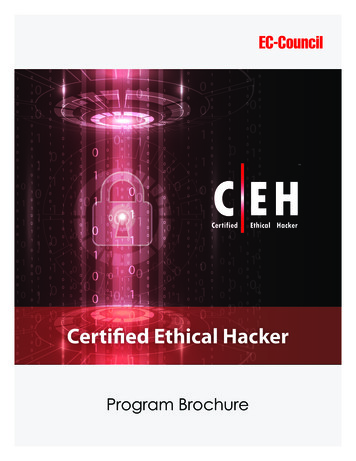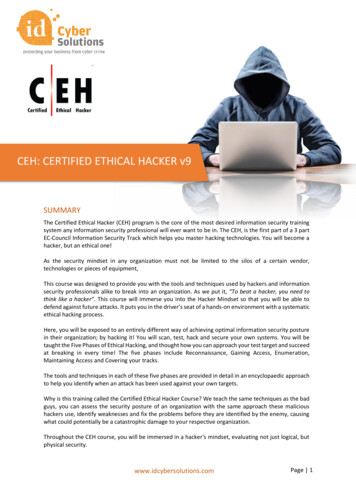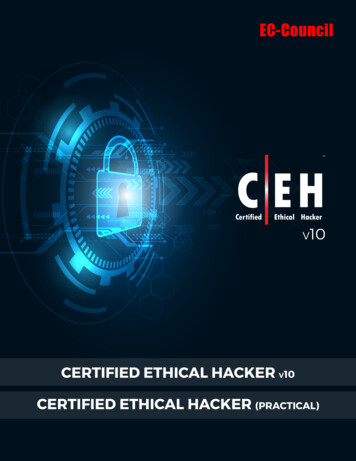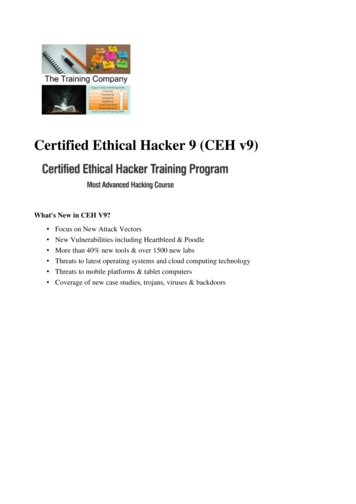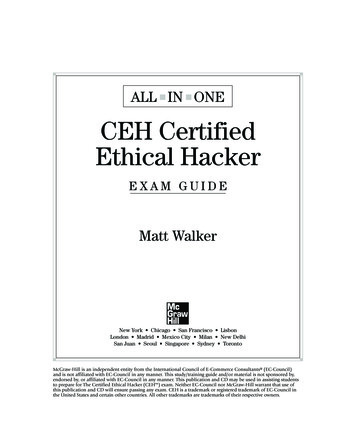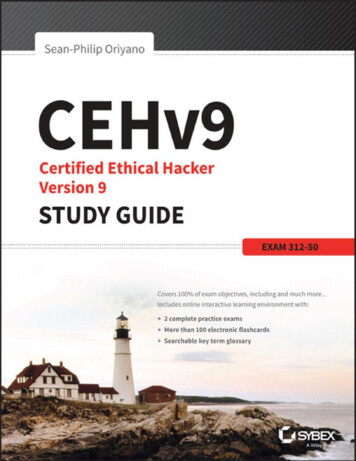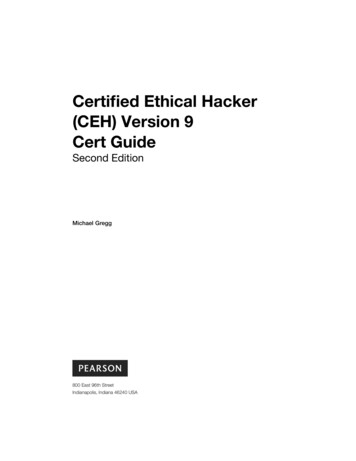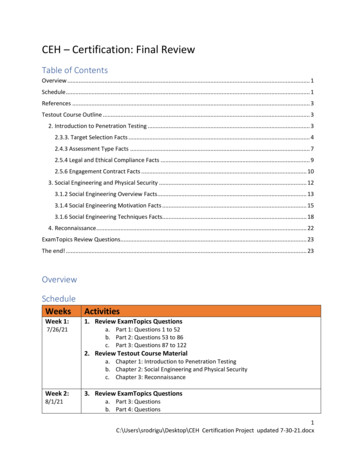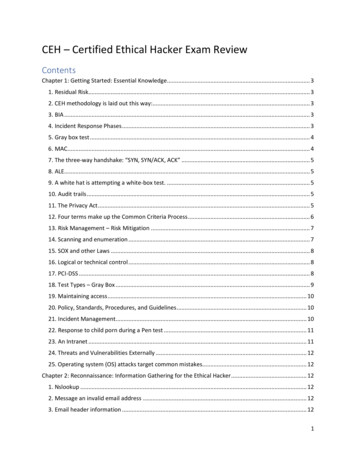
Transcription
CEH – Certified Ethical Hacker Exam ReviewContentsChapter 1: Getting Started: Essential Knowledge . 31. Residual Risk. 32. CEH methodology is laid out this way:. 33. BIA . 34. Incident Response Phases . 35. Gray box test . 46. MAC. 47. The three-way handshake: “SYN, SYN/ACK, ACK” . 58. ALE. 59. A white hat is attempting a white-box test. . 510. Audit trails . 511. The Privacy Act . 512. Four terms make up the Common Criteria Process . 613. Risk Management – Risk Mitigation . 714. Scanning and enumeration . 715. SOX and other Laws . 816. Logical or technical control . 817. PCI-DSS . 818. Test Types – Gray Box . 919. Maintaining access . 1020. Policy, Standards, Procedures, and Guidelines . 1021. Incident Management. 1022. Response to child porn during a Pen test . 1123. An Intranet . 1124. Threats and Vulnerabilities Externally . 1225. Operating system (OS) attacks target common mistakes. 12Chapter 2: Reconnaissance: Information Gathering for the Ethical Hacker . 121. Nslookup . 122. Message an invalid email address . 123. Email header information . 121
4. Google hacks - allintitle:CEH V10 . 135. Traceroute vs. Tracert . 136. Active vs. passive Footprinting. 137. Nslookup . 148. Split DNS. 149. CNAME and other record types . 1410. Protecting against DNS enumeration . 1511. Passive Footprinting . 1512. SOA Record . 1613. DNS Zone Trans – TCP 53 . 1614. Nslookup . 1615. DNS Poisoning . 1716. SOA. 1717. Active Directory–integrated DNS server. . 1718. EDGAR Database . 1719. Traceroute. 1820. Improving DNS Security . 1821. A zone file consists of which records? (Choose all that apply.) . 1922. OSRFramework . 2023. Google operators . 2124. Archive.org . 2125. Computer Security Incident Response Team (CSIRT)?. 2126. Regional Registries . 21Chapter 3: Scanning and Enumeration . 221. Metagoofil . 222. The p0f tool . 223. IDLE scan . 224. Ping sweep of a subnet . 235. Banner grabbing . 236. 631 is a network printer port . 247. Hping3 . 248. Define scan types . 249. ICMP Type 3, Code 13 . 252
10. Port-scanning methods . 25References . 25Chapter 1: Getting Started: Essential KnowledgeKey Points1. Residual RiskEnsure that any remaining risk is residual or low and accept the risk.2. CEH methodology is laid out this way: Reconnaissance (Footprinting),Scanning and enumeration,Gaining access,Escalating privileges,Maintaining access, andCovering tracks.3. BIAA business impact analysis (BIA) the organization looks at all the systems and processes in use anddetermines which ones are critical to continued operation. Additionally, the assessor (the person orcompany conducting the analysis) will look at all the existing security architecture and make anevaluation on the likelihood of any system or resource being compromised. Part of this is assigningvalues to systems and services, determining the maximum tolerable downtime (MTD) for any, andidentifying any overlooked vulnerabilities.4. Incident Response PhasesIn the preparation phase, your IR (incident response) team should be preparing for an incident.Preparation includes lots of things—some of which are mentioned here. But virtually anything you canthink of that does not involve actions taken during the incident belongs here. Training, exercises, andpolicies are all examples.IR phases can be different depending on whom you ask and what the moon phase is, but generally IR isbroken down into six ainment,Eradication,Recovery, andLessons learned.Preparation we already covered.3
Identification refers to the steps taken to verify it is actually an incident, and all the informationsurrounding that—source, destination(s), exploit used, malware used, and so on.Containment is the step used to cordon off the infected system(s) and to prevent any further spread ofinfection or attack.Eradication refers to steps taken to remove the malware (or other attack-related residuals, such asbackdoors).Recovery involves the steps taken to rebuild and restore the system(s) and network to pre-attack status(with better security, I might add).Finally, lessons learned is exactly what it sounds like, and should feed right back into your organization’spreparation phase.5. Gray box testA gray-box test is designed to replicate an inside attacker. Otherwise known as the partial knowledgeattack, the idea is to simulate a user on the inside who might know a little about the network, directorystructure, and other resources in your enterprise.You will probably find this one to be the most enlightening attack in out-briefing your clients in the realworld—it is amazing what you can get to when you are a trusted, inside user.You will often find in the real world that gray-box testing can also refer to a test where any insideinformation is given to a pen tester—you do not necessarily need to be a fully knowledgeable insideuser. In other words, if you have usable information handed to you about your client, you areperforming gray-box testing.6. MACAccess control is defined as the selective restraint of access to a resource, and there are several overallmechanisms to accomplish this goal. Mandatory access control (MAC) is one type that constrains the ability of a subject to access orperform an operation on an object by assigning and comparing “sensitivity labels.” Suppose aperson (or a process) attempts to access or edit a file. With MAC, a label is placed on the fileindicating its security level. If the entity attempting to access it does not have that level, orhigher, then access is denied. With mandatory access control, security is centrally controlled bya security policy administrator, and users do not have the ability to override security settings.This should not be confused with role-based access control (RBAC) systems, which may actuallyuse MAC to get the job done. The difference is in whether the information itself has a labeleddescription or whether the person accessing it has their own label. For example, in a classifiedarea, the information classified as Top Secret will have a label on it identifying it as such, whileyou, as an auditor, will have your own clearance and need-to-know label allowing you to accesscertain information.MAC is a property of an object; RBAC is a property of someone accessing an object.Discretionary access control (DAC) allows the data owner, the user, to set security permissionsfor the object. If you are on a Windows machine right now, you can create files and folders andthen set sharing and permissions on them as you see fit.4
7. The three-way handshake: “SYN, SYN/ACK, ACK”In step 1, the host sends a segment to the server, indicating it wants to open a communications session.Inside this segment, the host turns on the SYN flag and sets an initial sequence number (any random 32bit number).When the recipient gets the segment, it crafts a segment in response to let the host know it is open andready for the communications session. It does this by turning on the SYN and ACK flags, acknowledgingthe initial sequence number by incrementing it, and adding its own unique sequence number.Lastly, when the host gets this response back, it sends one more segment before the comm channelopens. In this segment, it sets the ACK flag and acknowledges the other’s sequence number byincrementing it.For example, suppose Host A is trying to open a channel with Server B. In this example, Host A likes thesequence number 2000, while Server B likes 5000. The first segment would look like this: SYN 1, ACK 0,ISN 2000. The response segment would look like this: SYN 1, ACK 1, ISN 5000, ACK NO 2001. The thirdand final segment would appear this way: SYN 0, ACK 1, SEQ NO 2001, ACK NO 5001.8. ALEWhen performing business impact analysis (or any other value analysis for that matter), the annualizedloss expectancy (ALE) is an important measurement for every asset.To compute the ALE, multiply the annualized rate of occurrence (ARO) by the single loss expectancy(SLE).The ARO is the frequency at which a failure occurs on an annual basis. In this example, servers fail onceevery five years, so the ARO would be 1 failure / 5 years 20 percent.9. A white hat is attempting a white-box test.Start with what kind of hacker he is. He is hired under a specific agreement, with full knowledge andconsent of the target, thus making him a white hat. Second, to address what kind of test he isperforming, simply look at what he knows about the system. In this instance, he has no prior knowledgeat all (apart from the agreement), thus making it a black-box test.10. Audit trailsA detective control is an effort used to identify problems, errors, or (in the case of post-attack discovery)cause or evidence of an exploited vulnerability—and an audit log or trail is a perfect example. Ideally,detective controls should be in place and working such that errors can be corrected as quickly aspossible. Many compliance laws and standards (the Sarbanes-Oxley Act of 2002 is one example)mandate the use of detective controls.11. The Privacy ActAs part of a pen test on a U.S. government system, you discover files containing Social Security numbersand other sensitive personally identifiable information (PII). You are asked about controls placed on thedissemination of this information. Which of the following acts should you check?The Privacy Act of 1974 protects information of a personal nature, including Social Security numbers.The Privacy Act defines exactly what “personal information” is, and it states that government agencies5
cannot disclose any personal information about an individual without that person’s consent. It also lists12 exemptions for the release of this information (for example, information that is part of a lawenforcement issue may be released).Keep in mind that the Privacy Act generally will define the information that is not available to you in andafter a test.Dissemination and storage of privacy information needs to be closely controlled to keep you out of hotwater. As a side note, how you obtain PII is oftentimes just as important as how you protect it oncediscovered. In your real-world adventures, keep the Wiretap Act (18 U.S. Code Chapter 119—Wire andElectronic Communications Interception and Interception of Oral Communications) and others like it inmind.The Federal Information Security Management Act (FISMA) is not designed to control thedissemination of PII or sensitive data. Its primary goal is to ensure the security of government systemsby promoting a standardized approach to security controls, implementation, and testing. The actrequires government agencies to create a security plan for their systems and to have it “accredited” atleast once every three years.The PATRIOT Act is not an effort to control personal information. Its purpose is to aid the U.S.government in preventing terrorism by increasing the government’s ability to monitor, intercept, andmaintain records on almost every imaginable form of communication. As a side effect, it has also servedto increase observation and prevention of hacking attempts on many systems.The Freedom of Information Act was not designed to tell you what to do with information. Its goal is todefine how you can get information—specifically information regarding how your governments work. Itdoes not necessarily help you in hacking, but it does provide a cover for a lot of information. Anythingyou uncover that could have been gathered through the Freedom of Information Act is considered legaland should be part of your overall test.12. Four terms make up the Common Criteria ProcessWhat term contains seven levels used to rate the target?Common Criteria is an international standard of evaluation of Information Technology (IT) products. Perthe website (https://www.commoncriteriaportal.org/) Common Criteria ensures evaluations and ratings“are performed to high and consistent standards and are seen to contribute significantly to confidencein the security of those products and profiles.”The EAL (Evaluation Assurance Level) is made up of seven levels, which are used to rate a product afterit has been tested.The current EAL levels are as follows: EAL1: Functionally tested EAL2: Structurally tested EAL3: Methodically tested and checked6
EAL4: Methodically designed, tested, and reviewed EAL5: Semi-formally designed and tested EAL6: Semi-formally verified, designed, and tested EAL7: Formally verified, designed, and testedTOE is the target of evaluation—the system or product actually being tested.ST is the security target—the documentation describing the target of evaluation and any securityrequirements.PP is the protection profile—a set of security requirements for the product type being tested.13. Risk Management – Risk MitigationAn organization’s leadership is concerned about social engineering and hires a company to providetraining for all employees. How is the organization handling the risk associated with social engineering?When it comes to risks, there are four different methods of attempting to deal with them.In risk mitigation, steps are taken to reduce the chance that the risk even will occur, and in this examplethat is exactly what is happening. Training on social engineering should help reduce the likelihood anemployee will fall victim (real-life concerns on this notwithstanding—we are talking about test questionshere).The acceptance of risk means the organization understands the risk is there, but they do not doanything about it. Why would a company take this action? Perhaps the chance a threat agent will (oreven can) exploit the risk is so low it makes the effort to mitigate it pointless. Or it could be the cost tomitigate simply costs more than any damage or recovery from exploitation in the first place. In any case,if the organization does nothing, they are accepting risk.Avoidance of risk means the organization takes steps to eliminate the service, action, or technologyaltogether. In other words, the risk is deemed so great the company would rather do without the assetor service in the first place. In the case of social engineering, unless the organization can work withoutemployees, avoiding this risk is nearly impossible.Transferring risk occurs when the organization puts the burden of risk on another party. For example,the company might hire an insurance company to pay off in the event a risk is exploited.14. Scanning and enumerationThe scanning and enumeration phase is where you will use things such as ping sweeps to discoveravailable targets on the network. This step occurs after reconnaissance. In this step, tools andtechniques are actively applied to information gathered during recon to obtain more in-depthinformation on the targets. For example, reconnaissance may show a network subnet to have 500 or so7
machines connected inside a single building, whereas scanning and enumeration would discover whichones are Windows machines and which ones are running FTP.15. SOX and other LawsWhich of the following was created to protect shareholders and the general public from corporateaccounting errors and fraudulent practices, and to improve the accuracy of corporate disclosures?The Sarbanes-Oxley Act (SOX; https://www.sec.gov/about/laws.shtml#sox2002) introduced majorchanges to the regulation of financial practice and corporate governance in 2002 and is arranged into 11titles. SOX mandated several reforms to enhance corporate responsibility, enhance financial disclosures,and combat corporate and accounting fraud, and it created the “Public Company Accounting OversightBoard,” also known as the PCAOB, to oversee the activities of the auditing profession.The Gramm-Leach-Bliley Act (GLBA; ivacy-andsecurity/gramm-leach-bliley-act) requires financial institutions—companies that offer consumersfinancial products or services such as loans, financial or investment advice, or insurance—to explaintheir information-sharing practices to their customers and to safeguard sensitive data. Under theSafeguards Rule, financial institutions must protect the consumer information they collect. GLBAprotects the confidentiality and integrity of personal information collected by financial institutions.The Health Insurance Portability and Accountability Act (HIPAA; www.hhs.gov/hipaa/) was designed toprotect the confidentiality of private health information. HIPAA contains privacy and securityrequirements and provides steps and procedures for handling and protecting private health data.16. Logical or technical controlA logical (or technical) control is one used for identification, authentication, and authorization. It can beembedded inside an operating system, application, or database management system. A security token(such as RSA’s SecureID) can provide a number that changes on a recurring basis that a user mustprovide during authentication, or it may provide a built-in number on a USB device that must beattached during authentication.A physical control is something, well, physical in nature, such as a lock or key or maybe a guard.17. PCI-DSSThe Payment Card Industry Data Security Standard (PCI-DSS) is a security standard for organizations thathandle credit cards. A council including American Express, JCB, Discover, MasterCard, and Visadeveloped standards for the protection and transmission of card data to reduce credit card fraud. It isadministered by the Payment Card Industry Security Standards Council. Validation of compliance isperformed annually.The standard is composed of 12 requirements:8
The Trusted Computer System Evaluation Criteria (TCSEC), also known as the Orange Book, was createdby the Department of Defense (DoD) and defines and provides guidance on evaluating access controlswithin a system. TCSEC defines four levels of validation: verified protectionmandatory protectiondiscretionary protection, andminimal protectionISO 27002 (www.iso27001security.com/html/27002.html) is an “information security standardpublished by ISO and the International Electrotechnical Commission (IEC) that recommends securitycontrols based on industry best practices.” This standard includes 13 objectives, ranging from structure,risk assessment, and policy to access controls, human resources security, and compliance.18. Test Types – Gray Box9
As part of the preparation phase for a pen test you are participating in, the client relays their intent todiscover security flaws and possible remediation. They seem particularly concerned about internalthreats from the user base. Which of the following best describes the test type the client is looking for?There are three types of tests—white, black, and gray—with each designed to test a specific threat. White tests the internal threat of a knowledgeable systems administrator or an otherwiseelevated privilege level user.Black tests external threats with no knowledge of the target.Gray tests the average internal user threat to expose potential security problems inside thenetwork.19. Maintaining accessIn which phase of the attack would a hacker set up and configure “zombie” machines?Zombies are basically machines the hacker has commandeered to do his work for him. If the attacker isreally good, the owners of the zombie machines do not even know their machines have been draftedinto the war. There is a bajillion method for maintaining access on a machine you’ve alreadycompromised and maintaining that access does not necessarily mean the system will be used as azombie—you could, for example, simply want to check in from time to time to see what new juicyinformation the user has decided to leave in a file or folder for you, or to check on new logins,credentials, and so on.20. Policy, Standards, Procedures, and GuidelinesWhich of the following should not be included in a security policy?Policy is a high-level document that does not get down and dirty into technical details/specifications andis intended to improve awareness. Policies are mandatory, generally short, and easy to understand,providing everyone with the rules of the road.Standards are mandatory rules designed to support a policy, and they must include one or morespecifications for hardware, software, or behavior.Procedures are step-by-step instructions for completing a task.Guidelines are not mandatory, but rather are recommendations for accomplishing a goal or on how toact in each situation.21. Incident ManagementWhich of the following is best defined as a set of processes used to identify, analyze, prioritize, andresolve security incidents?Incident management is the process of dealing with incidents and generally always has the samefeatures/steps: identify the problem or root cause,analyze and research the issue,contain the malicious effort,eradicate the effort, and10
resolve any damage caused.ECC defines the process as having eight steps:1. Preparation2. Detection and Analysis3. Classification/Prioritization4. Notification5. Containment6. Forensic Investigation7. Eradication and Recovery, and8. Post-incident Activities.The incident response team (IRT) is charged with handling this process.22. Response to child porn during a Pen testDuring an assessment, your pen test team discovers child porn on a system. Which of the following isthe appropriate response?First and foremost, in the real world, discovery of something that you think might be illegal activity putsyou and your team in a very, very tricky spot. Should you accuse fill-in-the-blank of a crime and involvethe authorities, you could be setting yourself up for lawsuits and all sorts of trouble. On the other hand,if you ignore it, you might be found complicit, or at the very least negligent.In the real world, the answer is to make sure your scope agreement advises you and the client of yourduty regarding potential criminal activity found during the scope of your investigation.No guessing is allowed—it better be iron-clad evidence, obvious to all, or you are in a world of hurt.Lastly, what potentially illegal activity you discover may determine your response regardless of ROE(Rules of Engagement). If you discover child porn, you could be guilty of a crime for not reporting it,which is not necessarily true for many other crimes. For example, if you witness someone breaking intoa house across your street or were performing a pen test and reasonably suspected someone hadalready compromised the network, you are not co
2. CEH methodology is laid out this way: Reconnaissance (Footprinting), Scanning and enumeration, Gaining access, Escalating privileges, Maintaining access, and Covering tracks. 3. BIA A business impact analysis (BIA) the organ
